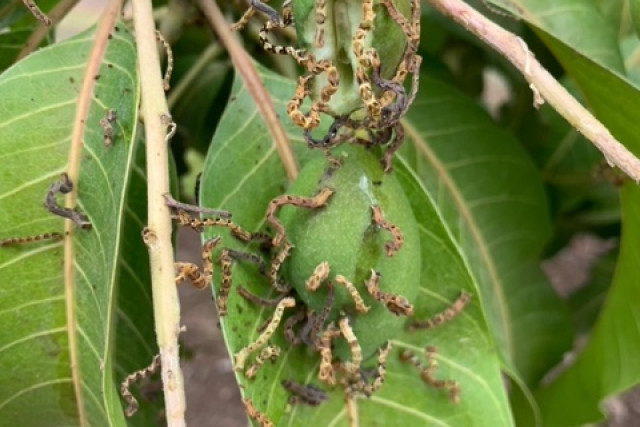General News
4 November, 2021
Invasive new pest poses threat to northern fruit
MANGO and lychee growers are being urged to be on the look-out for a new, highly invasive, typically Asian based pest, that was first detected in the Mareeba, Mutchilba and Biboohra district in September this year.

The Mango shoot looper not only poses a huge threat to Queensland's 60,000 tonne a year mango crop worth $180 million, but also affects lychees and potentially related plants such as rambutan, longan, cashew and pistachios.
Mango shoot looper is a known threat to commercial mango and lychee production, but its recent discovery means its broader impact is currently unknown.
Severe infestations may cause 80–100 per cent leaf defoliation and flower damage on affected trees and significant crop losses due to reduced photosynthesis capability and damage to flowers and immature fruit.
The pest does not affect the quality of mature mango or lychee fruit, which means no supply issues are anticipated this year, but damage to future crops could be devastating.
Biosecurity Queensland is urging growers to inspect mango and lychee trees regularly for caterpillars stripping leaves and/or flower panicles and should check new shoots and immature fruit for similar symptoms.
Historically, the Mango shoot looper has infected fruit crops in Hong Kong, the Philippines, Malaysia, Singapore, Thailand, Taiwan, Indonesia, India, the North-eastern Himalayan region and Guam.
The Department of Agriculture and Fisheries is completing surveillance to determine the extent of its distribution and to formulate response and control strategies and appropriate chemical use advice for industry.
Queensland grows 67 per cent of the national mango crop and around 50 per cent of Australia's lychees are grown in northern Queensland and as mangoes are common backyard trees in Queensland, home gardeners will also be affected.
Adult mango shoot loopers can fly and spread naturally in localised areas from tree to tree. Their spread may be enhanced by strong winds and by human-assisted movement of infested plant material.
Moths are attracted to lights of vehicles and caravans. Road traffic, particularly tourists and caravans may inadvertently move moths when larvae and pupa drop onto vehicles parked under affected trees.
Anyone who finds evidence of mango shoot looper must report the incident as soon as possible to Biosecurity Queensland on 13 25 23.
FAST FACTS
A type of moth, the adult varieties of the mango shoot looper are very pale brown or cream in colour. Its larvae grow to 1.7- 2.2cm long and vary in colour from a mottled brown to black.
The moths have a looping appearance when moving and may make silken threads that hang from the plant to assist their movement to new feeding areas.
They feed voraciously on mango tree leaves – leaving only the midribs and veins. They also feed on tender shoots, flowers and immature fruit, and can severely damage tree canopies.
Newly formed pupae are typically around 8mm long, green in colour darkening to brown before adult emergence and may be seen in large numbers on the upper surfaces of leaves.
The insect completes its full life cycle in 15–19 days, and the larval period lasts 8 or 9 days.



